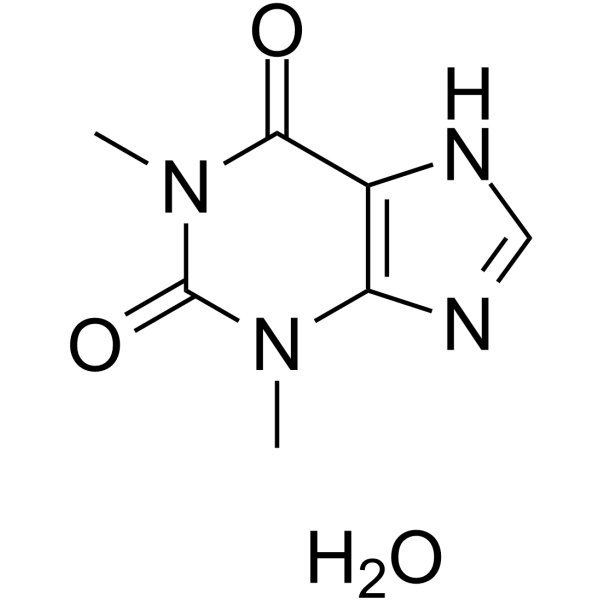Theophylline monohydrate
Modify Date: 2024-01-09 12:25:12

Theophylline monohydrate structure
|
Common Name | Theophylline monohydrate | ||
|---|---|---|---|---|
| CAS Number | 5967-84-0 | Molecular Weight | 198.17900 | |
| Density | N/A | Boiling Point | 454.1ºC at 760 mmHg | |
| Molecular Formula | C7H10N4O3 | Melting Point | 270-274°C | |
| MSDS | N/A | Flash Point | N/A | |
Use of Theophylline monohydrateTheophylline (1,3-Dimethylxanthine) monohydrate is a potent phosphodiesterase (PDE) inhibitor, adenosine receptor antagonist, and histone deacetylase (HDAC) activator. Theophylline (1,3-Dimethylxanthine) monohydrate inhibits PDE3 activity to relax airway smooth muscle. Theophylline (1,3-Dimethylxanthine) monohydrate has anti-inflammatory activity by increase IL-10 and inhibit NF-κB into the nucleus. Theophylline (1,3-Dimethylxanthine) monohydrate induces apoptosis. Theophylline (1,3-Dimethylxanthine) monohydrate can be used for asthma and chronic obstructive pulmonary disease (COPD) research[1][2][3][4][5]. |
| Name | Theophylline Monohydrate |
|---|---|
| Synonym | More Synonyms |
| Description | Theophylline (1,3-Dimethylxanthine) monohydrate is a potent phosphodiesterase (PDE) inhibitor, adenosine receptor antagonist, and histone deacetylase (HDAC) activator. Theophylline (1,3-Dimethylxanthine) monohydrate inhibits PDE3 activity to relax airway smooth muscle. Theophylline (1,3-Dimethylxanthine) monohydrate has anti-inflammatory activity by increase IL-10 and inhibit NF-κB into the nucleus. Theophylline (1,3-Dimethylxanthine) monohydrate induces apoptosis. Theophylline (1,3-Dimethylxanthine) monohydrate can be used for asthma and chronic obstructive pulmonary disease (COPD) research[1][2][3][4][5]. |
|---|---|
| Related Catalog | |
| Target |
Human Endogenous Metabolite |
| In Vitro | Theophylline (1,3-Dimethylxanthine) monohydrate (1-1000 µM) inhibits cAMP hydrolysis by PDE in homogenates of bronchial tissue to relax human bronchus and pulmonary arteries[1]. Theophylline (1,3-Dimethylxanthine) monohydrate (10 µg/mL; 24 h; eosinophils) induces apoptosis through a reduction in the antiapoptotic protein Bcl-2[2]. Theophylline (1,3-Dimethylxanthine) monohydrate (0-500 µM; 2 h; A549 cells) inhibits NF-κB activation, I kappa B alpha (I-κBα) degradation and decreases the level of IL-6 in a concentration-dependent manner[3]. Theophylline (1,3-Dimethylxanthine) monohydrate (0-1000 µM; 30 min; A549 cells) induces histone deacetylase activity to decrease inflammatory gene expression[4]. Western Blot Analysis[3] Cell Line: A549 cells Concentration: 0, 20, 100 and 500 µM Incubation Time: 2 hours Result: Decreased the expression of NF-κB p65 and I-κBα degradation in a concentration-dependent manner. Western Blot Analysis[2] Cell Line: Eosinophils Concentration: 10 µg/mL Incubation Time: 24 hours Result: Decreased the expression of Bcl-2. |
| In Vivo | Theophylline (1,3-Dimethylxanthine) (100 mg/kg; i.p.; daily, for 9 d; male Swiss mice) has anti-inflammatory activity in mice and increases IL-6 and IL-10 levels and inhibits TNF-α and NO[1]. Animal Model: Male Swiss mice[1] Dosage: 100 mg/kg Administration: Intraperitoneal injection; daily, for 9 days Result: Increased IL-6 and IL-10 levels and inhibited TNF-α and NO. |
| References |
[5]. Barnes PJ. Theophylline. Am J Respir Crit Care Med. 2013 Oct 15;188(8):901-6. |
| Boiling Point | 454.1ºC at 760 mmHg |
|---|---|
| Melting Point | 270-274°C |
| Molecular Formula | C7H10N4O3 |
| Molecular Weight | 198.17900 |
| Exact Mass | 198.07500 |
| PSA | 81.91000 |
| Risk Phrases | R23/24/25 |
|---|---|
| Safety Phrases | S22-S36/37/39 |
| RIDADR | 2811 |
| HS Code | 2933990090 |
| HS Code | 2933990090 |
|---|---|
| Summary | 2933990090. heterocyclic compounds with nitrogen hetero-atom(s) only. VAT:17.0%. Tax rebate rate:13.0%. . MFN tariff:6.5%. General tariff:20.0% |
| EINECS 200-385-7 |
| MFCD00151659 |
| Theophylline monohydrate |